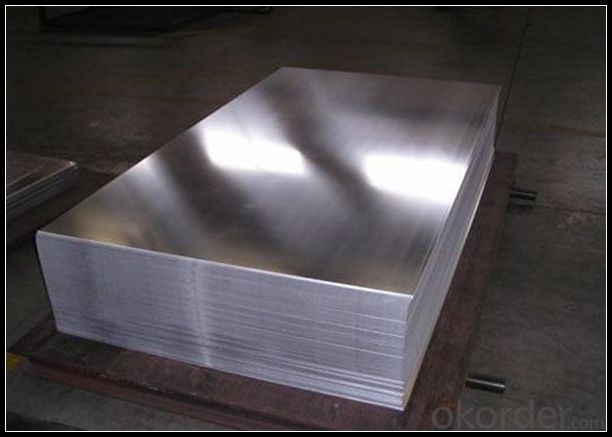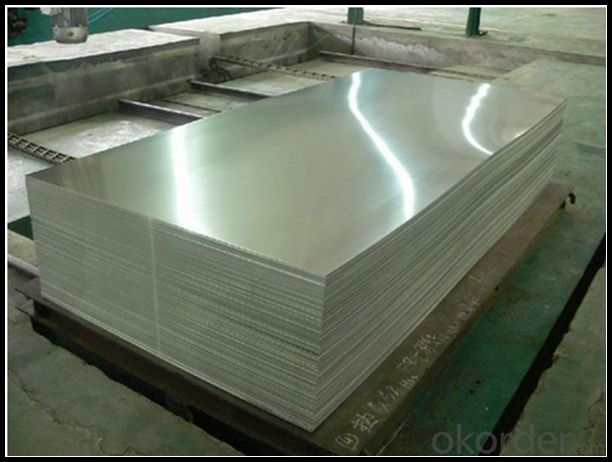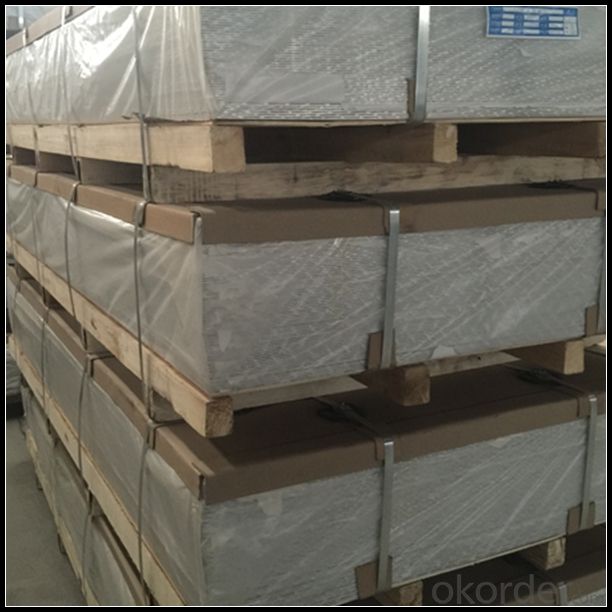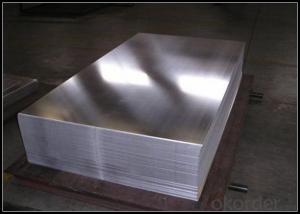Mill Finished Aluminium Sheet for Building Ceiling
- Loading Port:
- Shanghai
- Payment Terms:
- TT OR LC
- Min Order Qty:
- 5 m.t.
- Supply Capability:
- 10000 m.t./month
OKorder Service Pledge
OKorder Financial Service
You Might Also Like
Item specifice
1. Specification of Mill Finished Aluminium Sheet for Building Ceiling
ALLOY | AA1050 AA1060 AA1070 AA1100 ETC AA3003 AA3004 AA3005 AA3104 AA3105 ETC AA5005 AA5052 AA5083 AA5754 ETC AA8011 AA8006 AA8079 ETC |
TEMPER | H14,H16,H18,H22,H24,H26,H32,O/F |
THICKNESS | ≥0.2MM |
WIDTH | 30mm-2100mm |
COIL WGT | 2Mt - 3Mt |
COIL ID | φ508mm,φ610mm |
SURFACE | PE Protecting film |
STANDARD | GB/T 3880-2006 |
2. Application of Mill Finished Aluminium Sheet for Building Ceiling
(1).Interior: wall cladding, ceilings, bathrooms, kitchens and balconies, shutters, doors...
(2).Exterior: wall cladding, facades, roofing, canopies, tunnels,column covers , renovations...
(3).Advertisement: display platforms, signboards, fascia, shop fronts...
3. Feature of Mill Finished Aluminium Sheet for Building Ceiling
Surfact Quality :
Be free from Oil Stain, Dent, Inclusion, Scratches, Stain, Oxide Dicoloration, Breaks, Corrosion, Roll Marks, Dirt Streaks and other defect which will interfere with use,
Mechenical Property:
Chemical Composite and Mechanical Property
4. Certificate:
SGS and ROHS(if client request, paid by client), MTC(plant provided), Certificate of Origin(FORM A, FORM E, CO), Bureau Veritas and SGS (if client request, paid by client), CIQS certificate
5. Image of Mill Finished Aluminium Sheet for Building Ceiling



6. Package and shipping of Mill Finished Aluminium Sheet for Building Ceiling
First, plastic cloth with drying agent inside; Second, Pearl Wool ; Third, wooden cases with dry agent , fumigation wooden pallets, aluminum surface could cover blue PVC film
7. FAQ
1) What is the delivery time?
Dpends on actual order, around 20 to 35 days
2)What is the QC system:
We have QC staff of 20 persons and advanced equipment, each production is with MTC traced from Aluminum ingot lot.
3) What market do you mainly sell to?
Australia, America, Asia, Middle East, Western Europe, Africa etc
- Q:What are the different methods of bending aluminum sheets?
- There exist multiple techniques for bending aluminum sheets, each possessing its own merits and limitations. Some frequently employed approaches include: 1. Press Brake Bending: This method entails securing the aluminum sheet between a punch and a die on a press brake machine. Force is then applied through the punch, which pushes against the die to bend the sheet. Press brake bending is most suitable for high-volume production and ensures accurate and consistent bends. 2. Roll Bending: Also referred to as the three-roll bending process, this technique employs a set of three rollers to gradually shape the aluminum sheet as desired. Roll bending is effective for creating cylindrical or conical forms and finds applications in industries such as automotive and aerospace. 3. Stretch Bending: In this method, the aluminum sheet is clamped at both ends while a stretching force is applied in the middle. This results in both elongation and bending of the sheet, yielding a curved shape. Stretch bending is commonly utilized to produce curved profiles with a smooth and uniform finish. 4. Heat Bending: By subjecting the aluminum sheet to heat, it becomes more malleable and can be easily shaped into desired forms. Heat bending is often carried out using a heat gun or an oven to soften the metal, followed by manual or mechanical bending. This technique is beneficial for crafting intricate and complex shapes. 5. Incremental Bending: This technique involves bending the aluminum sheet in multiple steps or increments, with the bend angle gradually increasing after each step. Incremental bending provides greater control over the bending process and is commonly employed for forming U-shaped or V-shaped bends. 6. Roll Forming: In roll forming, the aluminum sheet is fed through a series of rollers, each bending the sheet a little more. This continuous process is well-suited for producing long and consistent bends, commonly seen in the manufacturing of aluminum profiles and extrusions. It is important to note that the choice of bending method depends on various factors, including the desired bend angle, the thickness and grade of the aluminum sheet, the required precision, and the production volume.
- Q:is there any kind of deoderant, other than those crystals that smell, that don't have aluminum in it?
- Mennen makes a line of plain old deodorant. They also make antiperspirants, though, so be sure you read the label.
- Q:how to make aluminum products bright? How to polish or clean the products punch formed by 0.3mm aluminum sheet?
- you can try to grind it with magnetic grinder.
- Q:What are the surface treatment requirements for aluminum sheets in the food industry?
- In the food industry, aluminum sheets are commonly used due to their excellent corrosion resistance and lightweight properties. However, certain surface treatment requirements need to be met to ensure the safety and quality of the food products. Firstly, aluminum sheets used in the food industry should undergo a cleaning process to remove any impurities or contaminants. This can be achieved through various methods such as chemical cleaning, alkaline cleaning, or mechanical cleaning. The purpose is to eliminate any potential sources of contamination that could affect the food's taste, odor, or safety. Furthermore, the surface of the aluminum sheets should be properly finished to prevent any interactions between the metal and the food. Anodizing is a popular surface treatment method, which creates a protective oxide layer on the aluminum surface. This layer not only enhances corrosion resistance but also provides a barrier against any potential migration of aluminum ions into the food. Additionally, it is crucial to ensure that the surface treatment materials used are food-grade and compliant with relevant regulations. The food industry has specific guidelines and standards in place to ensure the safety and suitability of materials that come into contact with food. Therefore, the surface treatment process should adhere to these standards to prevent any health hazards or contamination risks. Regular inspection and maintenance of the surface treatment are also necessary to guarantee its effectiveness over time. This includes monitoring the integrity of the protective layer, identifying any signs of wear or damage, and taking appropriate actions to address them promptly. In summary, the surface treatment requirements for aluminum sheets in the food industry include thorough cleaning, proper finishing, the use of food-grade materials, and regular maintenance. These measures are crucial to ensure the safety and quality of the food products and to comply with industry regulations and standards.
- Q:I've created a sculpture out of aluminum foil, but it's pretty flimsy. What can I paint or cover it with that would harden and support it? I was thinking a resin or something, but I have no experience with resins or epoxies... Any suggestions?
- Rigid Wrap is plaster-infused gauze. You can buy it at the art supply store or at a medical supply store. The latter is cheaper. It comes on a roll so you can cut off small chunks. Wet each piece and apply it to your sculpture. The first layer may be the most difficult. I would wrap the plaster gauze around the structure so the gauze overlaps gauze. It may not stick to the aluminum but it will stick to itself. Start at the bottom and let it dry, then add another layer. As mentioned, adding too much may compromise the structure so work slowly and allow time to dry between layers.
- Q:ive been working with parts for a robot without gloves and ive manged to 3 cuts in my fingers, also my hands get covered with powdered aluminum from sanding the peices, can this be dangerous to my health?
- When working with aluminum, wear leather gloves to protect your hands, goggles to protect your eye and a dust mask to protect your lungs. Aluminum has been linked to Alzheimer's and other neurological conditions.
- Q:What are the different types of protective films available for aluminum sheets?
- There are several different types of protective films available for aluminum sheets, each offering unique features and benefits. Some common types include: 1. Polyethylene (PE) film: PE film is a popular choice for protecting aluminum sheets due to its versatility and cost-effectiveness. It provides a temporary barrier against scratches, dust, dirt, and moisture during storage, transportation, and fabrication processes. PE film can be easily applied and removed without leaving any residue or damaging the surface of the aluminum sheet. 2. Polyvinyl Chloride (PVC) film: PVC film is another commonly used protective film for aluminum sheets. It offers excellent protection against scratches, abrasions, and UV rays. PVC film is known for its durability, making it suitable for long-term applications. It is available in various thicknesses and can be customized to meet specific requirements. 3. Polyolefin film: Polyolefin film is a type of shrink film that provides all-around protection for aluminum sheets. It is highly resistant to punctures, tears, and moisture. Polyolefin film can be heat-shrunk onto the aluminum surface, creating a tight seal and preventing any damage during handling, storage, or transit. 4. Polyester film: Polyester film is a high-performance protective film that offers superior resistance against chemicals, solvents, and extreme temperatures. It provides an excellent barrier against moisture, preventing corrosion and oxidation of the aluminum sheet. Polyester film is often used in demanding applications where maximum protection is required. 5. Adhesive-backed film: Adhesive-backed films are self-adhesive protective films that can be easily applied and securely bonded to aluminum sheets. They provide a temporary protective layer against scratches, stains, and other surface damages. Adhesive-backed films are available in different adhesive strengths, allowing for easy removal without leaving any residue or damaging the aluminum surface. It is important to select the appropriate type of protective film based on the specific requirements and conditions in which the aluminum sheets will be used.
- Q:What is the typical flammability rating of aluminum sheets?
- Aluminum sheets typically have a flammability rating of Class A. This means that they are highly resistant to fire and will not easily ignite or contribute to the spread of flames. Aluminum is a non-combustible material, making it a popular choice for various applications where fire safety is a concern, such as construction, transportation, and aerospace industries. It has a high melting point and excellent heat dissipation properties, which further enhances its fire-resistant characteristics.
- Q:Can aluminum sheet be used for architectural façade systems?
- Yes, aluminum sheet can be used for architectural façade systems. Aluminum is a popular choice for building exteriors due to its lightweight, durability, and corrosion resistance properties. It can be easily manipulated and fabricated into various shapes and sizes, making it suitable for creating intricate designs and architectural elements. Additionally, aluminum can be finished with different coatings or treatments to enhance its appearance and protect it from weathering. Its versatility, aesthetic appeal, and long-term cost-effectiveness make aluminum sheet an excellent choice for architectural façade systems.
- Q:How do you clean and maintain aluminum sheets?
- To clean and maintain aluminum sheets, follow these steps: 1. Start by wiping the surface of the aluminum sheet with a soft cloth or sponge to remove any loose dirt or debris. Avoid using abrasive materials that can scratch the surface. 2. For regular cleaning, mix a mild detergent or dish soap with warm water in a bucket or sink. Dip the cloth or sponge into the soapy water and gently scrub the aluminum sheet, applying light pressure in circular motions. Be sure to clean both sides of the sheet. 3. Rinse the sheet thoroughly with clean water to remove any soap residue. It's important to remove all traces of detergent as it can leave behind a film or residue. 4. For stubborn stains or grime, you can use a non-abrasive cleaner specifically designed for aluminum surfaces. Apply the cleaner to a cloth or sponge and scrub the affected areas. Rinse with clean water afterward. 5. After cleaning, dry the aluminum sheet thoroughly with a clean, soft cloth to prevent water spots or streaks. It's important to dry it completely to avoid any moisture that can lead to corrosion or oxidation. 6. To maintain the aluminum sheet's shine and protect it from future damage, you can apply a thin layer of aluminum polish or wax using a clean cloth. This will create a protective barrier and enhance the sheet's appearance. 7. Regularly inspect the aluminum sheet for any signs of damage, such as scratches or dents. If you notice any issues, take appropriate steps to repair or replace the sheet to prevent further damage. By following these steps, you can effectively clean and maintain aluminum sheets, ensuring their longevity and preserving their appearance.
1. Manufacturer Overview |
|
|---|---|
| Location | |
| Year Established | |
| Annual Output Value | |
| Main Markets | |
| Company Certifications | |
2. Manufacturer Certificates |
|
|---|---|
| a) Certification Name | |
| Range | |
| Reference | |
| Validity Period | |
3. Manufacturer Capability |
|
|---|---|
| a)Trade Capacity | |
| Nearest Port | |
| Export Percentage | |
| No.of Employees in Trade Department | |
| Language Spoken: | |
| b)Factory Information | |
| Factory Size: | |
| No. of Production Lines | |
| Contract Manufacturing | |
| Product Price Range | |
Send your message to us
Mill Finished Aluminium Sheet for Building Ceiling
- Loading Port:
- Shanghai
- Payment Terms:
- TT OR LC
- Min Order Qty:
- 5 m.t.
- Supply Capability:
- 10000 m.t./month
OKorder Service Pledge
OKorder Financial Service
Similar products
New products
Hot products
Related keywords



























